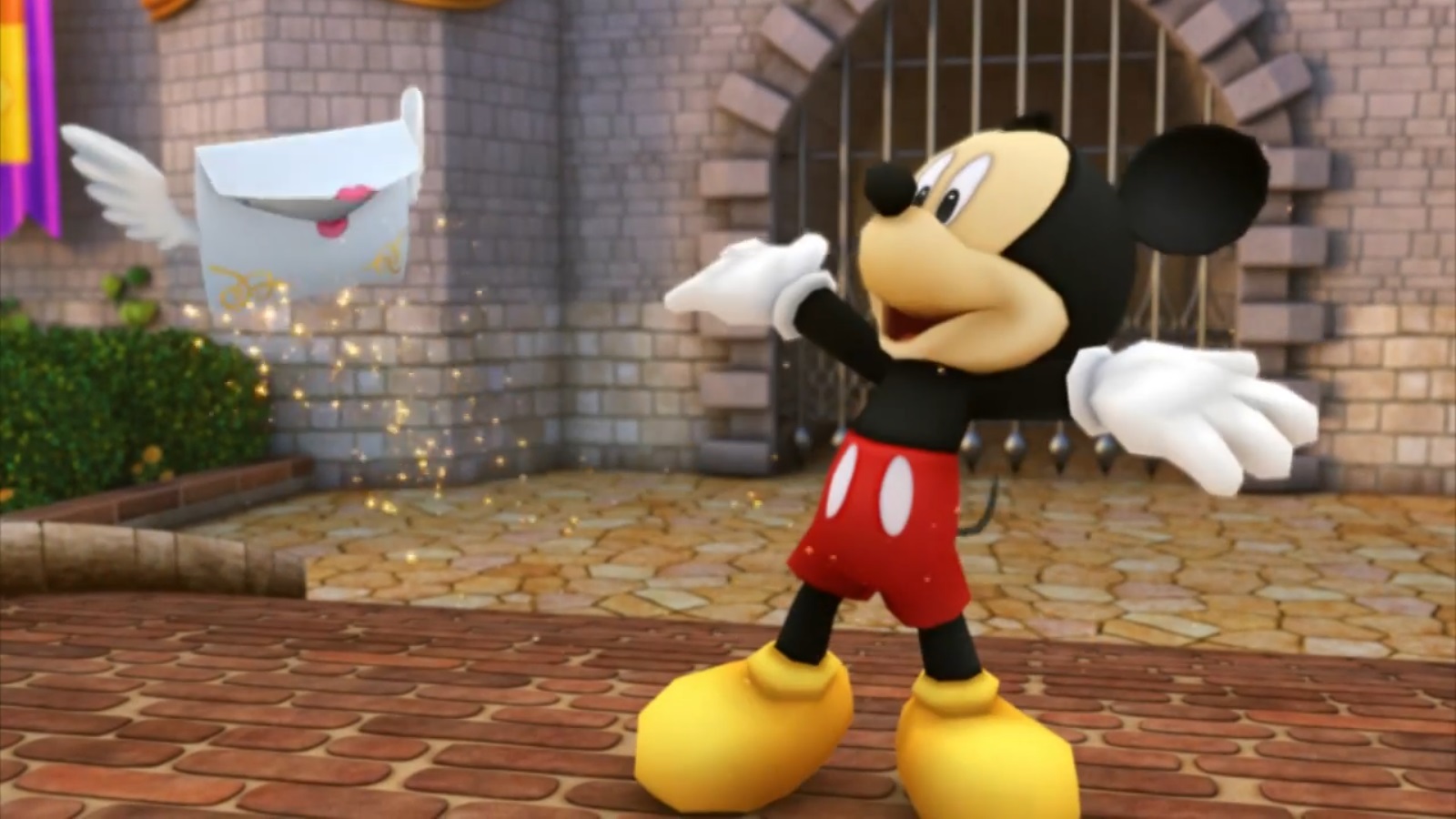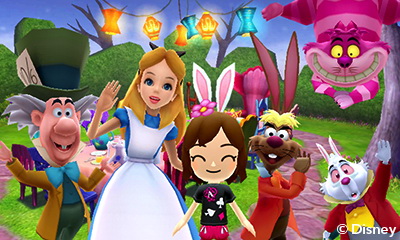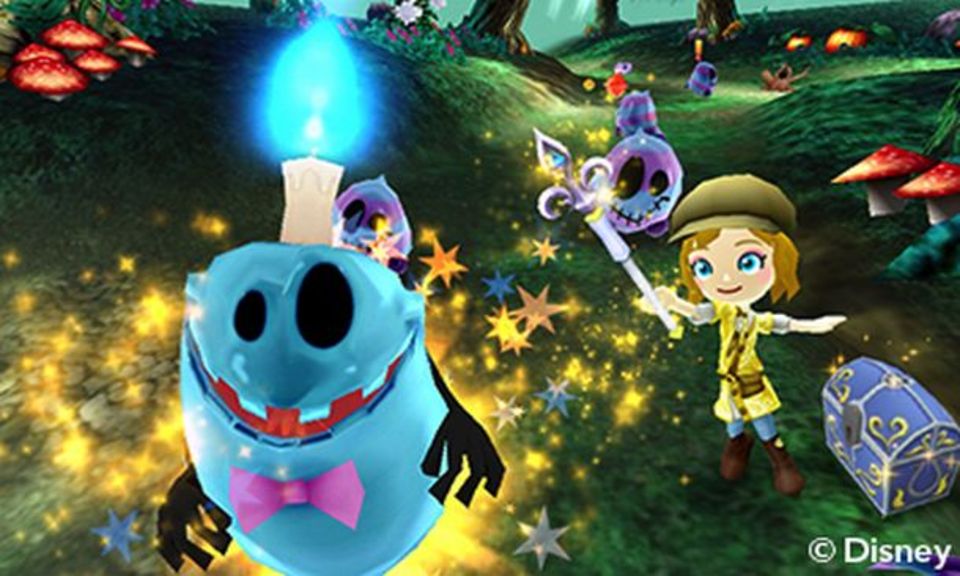
Last year’s Animal Crossing: New Leaf proved to be a major success for Nintendo, and it was one of the driving forces behind the spike in 3DS sales in 2013. In Japan, however, the game had been out for nearly a year before we saw it, and many gamers there were craving something new. That saving grace came in the form of a game called Disney Magic Castle: My Happy Life, which shipped nearly a half million copies at launch there. Now translated with a new name and same premise, Disney Magical World is ready to make its debut in North America.
Disney Magical World follows the basic idea all of us had when we were 8 years old:
What if you could live in Disneyland?
Every Disney loving child had this thought when I was younger, and kids today continue to have the thought. Disney has sort of made this possible through timeshares and luxury condos on the Disneyworld property in Florida. For those of us who live in reality though, this game provides a peek at what our lives could have been like if we lived in the Disney Universe.
Release Date: April 11th 2014
Overall Rating: E for Everyone
Consoles: Nintendo 3DS
The game starts as you (well Mii – You as your Mii) suddenly appearing in a town called Castleton, which is laid out pretty similarly to the front gates at the Magic Kingdom. You are greeted by Mickey and Minnie Mouse, and some of the townsfolk, and then your adventure begins.

There are miniature tutorials, but you’ll learn more simply by playing through the prologue, which itself is part of the game and serves to teach you all the ins and outs of the game. You’ll learn about the basics of the game through the whole thing, and in the process unlock one of the game’s first movie set levels. The prologue should take around 2-3 hours to complete, but by then you should have a good understanding of how everything works, from fishing to running the cafe. Fishing isn’t an income source in this game. You simply catch fish, document them, take whatever item they are holding and then release them. On the flipside, you CAN obtain some pretty rare items from fishing, so don’t pass by any spot without catching and releasing everything.
The game itself doesn’t progress through levels. You must collect stickers by achieving certain tasks. During the prologue (which is 16 stickers,) they’re handed to you in the form of linear objectives. You must essentially fulfill one sticker before you can another. Once the prologue is over, however, it becomes a bit more wide open. You can fulfill stickers in any order you want, though some will just come as you play through the main quest. You must, however, collect stickers and progress through the main quest to do things like grow your cafe, access new parts of the map or play unlocked quests. There are 100 in all. Once the prologue is over, you will unlock Cinderella’s world, and you’re summoned by the wizard Yen Sid (I can’t even make this up) to take up magic and defeat ghosts that have messed plans up for the upcoming ball.
These worlds now become a part of your main game. As you play through the “episodes” as the game calls them, you will unlock more within that world but need to have a certain number of stickers to play after a while. Not to fret, however. Once you have beaten to the point where you have to get more stickers, a new world usually unlocks. In addition to Cinderella, there are worlds for Winnie the Pooh, Aladdin and Alice in Wonderland. All carry their own signature styles, levels, items and unlockables. While on the surface the worlds don’t necessarily interact with each other, you’ll need items from one world to unlock items in another. Fortunately, the level progression across all of these make it so that you can easily achieve these objectives if you’re paying attention. While the main map will show you what you’re about to unlock with your stickers, the sub-worlds will not, so you’ll want to keep track of what level is available at your sticker level. You will have to keep going back to each world regularly. Once you get far enough into the game, Cameron the flying camera will appear and ask you to take a commemorative photo with certain characters in that region. Some photos will not unlock stickers, but some will.
 All of these worlds’ episodes, with the exception of Winnie the Pooh’s Hundred Acre Wood have maze-style levels complete with different types of ghosts and traps. Each level should take anywhere from 5-10 minutes, and always culminate with a boss fight. You only have 3 moves: Run, attack and evade, but it’s all you need. Hundred Acre Woods has more task filled episodes (ie. make Winnie the Pooh a honey pot, or grow vegetables) but despite any difficulties, I’d say it’s the most important world of the game since it helps you the most in the main world with your cafe, clothing and furniture collections.
All of these worlds’ episodes, with the exception of Winnie the Pooh’s Hundred Acre Wood have maze-style levels complete with different types of ghosts and traps. Each level should take anywhere from 5-10 minutes, and always culminate with a boss fight. You only have 3 moves: Run, attack and evade, but it’s all you need. Hundred Acre Woods has more task filled episodes (ie. make Winnie the Pooh a honey pot, or grow vegetables) but despite any difficulties, I’d say it’s the most important world of the game since it helps you the most in the main world with your cafe, clothing and furniture collections.
The cafe is a huge component of this game, and one you can’t ignore since it’s your best source of income. 10 stickers in, you will unlock the deed to the cafe by meeting the King at his castle, and from there can begin to make easier money. In the cafe, you make snacks, drinks and desserts for Castleton’s patrons to come in and enjoy. You start with basic 10 coin items. As your restaurant levels up through tasks you do, or you unlock recipes, you can make fancier items and charge more. The main X-Factor here are your materials. If you do not have the right materials, you can’t make the item. You can obtain these materials by scrounging around Castleton, though you’ll quickly see that it won’t get you far. You will have to find more of these food items in the various subworlds, and also by growing them in Hundred Acre Wood with Rabbit’s help. That garden in Hundred Acre Woods will be your lifesaver since you will often find seeds to plant for items that are almost impossible to find on their own in the open. Play through to 30 stickers, and the cafe transforms and expands into your home as well on the top floor, which you can decorate with the various furniture sets that exist in the game. Your cafe can also be set up in various themes to attract other characters in too.
This is where we discuss the collection aspect of Disney Magical World, and where it gains a lot of its comparisons to  the Animal Crossing series. There are collectibles all over the place. You can collect furniture sets, clothing, shoes, hairstyles and even trading cards. The trading cards are available free of charge throughout, but you can only obtain two a day by greeting Disney characters when they have a card icon above their heads. Expect lots of duplicates throughout, but cards are available in common, rare, and super rare format. 300 cards exist in all, and I’d advise against going through the catalogue past the basic characters or else you’ll spoil who else you’re going to see in the game. Outside of that, clothing and furniture can be obtained through Scrooge McDuck’s shop where he and Huey, Dewey and Louie work, or through creating them. Daisy Duck runs a tailoring shop where she makes most of the important clothes you need to progress, and Chip and Dale run a workshop where they can make materials for your cafe, bedroom or to fulfill quests. The number of items you can make increases through sticker levels, or through recipes you pick up here and there. Clothing, as always is the case in these games happens to be the toughest collection to crack. There are over 140 individual outfits, let alone pieces of clothing. Each individual outfit contains multiple aspects to it (some can be created on the spot in full) and wearing one gives you an “Ace Ensemble” which you can wear and show off to townsfolk for points (think Facebook likes, but in person.) Those points can be used at the fortune teller to buy sparkles, which you’re told have benefits for wearing them around, but were more of an annoyance to me because they interfered with item foraging (items you can scrounge or harvest appear as sparkles on the ground.)
the Animal Crossing series. There are collectibles all over the place. You can collect furniture sets, clothing, shoes, hairstyles and even trading cards. The trading cards are available free of charge throughout, but you can only obtain two a day by greeting Disney characters when they have a card icon above their heads. Expect lots of duplicates throughout, but cards are available in common, rare, and super rare format. 300 cards exist in all, and I’d advise against going through the catalogue past the basic characters or else you’ll spoil who else you’re going to see in the game. Outside of that, clothing and furniture can be obtained through Scrooge McDuck’s shop where he and Huey, Dewey and Louie work, or through creating them. Daisy Duck runs a tailoring shop where she makes most of the important clothes you need to progress, and Chip and Dale run a workshop where they can make materials for your cafe, bedroom or to fulfill quests. The number of items you can make increases through sticker levels, or through recipes you pick up here and there. Clothing, as always is the case in these games happens to be the toughest collection to crack. There are over 140 individual outfits, let alone pieces of clothing. Each individual outfit contains multiple aspects to it (some can be created on the spot in full) and wearing one gives you an “Ace Ensemble” which you can wear and show off to townsfolk for points (think Facebook likes, but in person.) Those points can be used at the fortune teller to buy sparkles, which you’re told have benefits for wearing them around, but were more of an annoyance to me because they interfered with item foraging (items you can scrounge or harvest appear as sparkles on the ground.)
Finally, there is favor granting, similar to the task system of Animal Crossing. Favours are available for numerous characters in the main world, and appear in the form of a flashing stick pin on the main map. You will be asked for an item of some sort, and given a time limit in which to fulfill. Time limits range from 10 minutes or so all the way to 13 hours. The items could be anything – Clothing, seeds, raw materials, etc. Supply somebody with the item or items they’re seeking, and they will give you something in exchange (usually a recipe or harder to find material.) There are usually 2 or 3 favours available to grant at any time.
The Spotpass feature allows you to visit other friends’ Castleton setups, and give them gifts. Unfortunately, because the game has not yet been released, there was no way for me to test this feature out. However, reviews across the Japanese boards seem to say that the feature works pretty flawlessly.

Repeat this cycle over and over again, and fulfill task after tasks and you should have a good chunk of the stickers. This should probably take you around 40-50 hours of solid, dedicated gameplay to achieve. Even though Castleton and the associated subworlds look small in stature, the contents of the game are huge. Between all the collectibles, if you aren’t cheating and time traveling, it should take you about a year to collect everything. As a summer-2013 Animal Crossing addict, one thing will keep me glued to this game more than that one: Your townspeople (the Disney Universe characters) don’t randomly move away. That was one of the reasons I stopped playing New Leaf. It didn’t matter how much I told my townspeople not to move away – Miss a day and they’d just up and leave anyway. Here, because the people you get to know by name are all permanent fixtures in your town, the beat will go on.
Now that I’ve talked about the game itself in length, let’s talk about the mechanics. The graphics in this game are good enough. There’s bits of graphic glitching and slowdown here and there, but nothing so substantial that it takes away from the game. The game never froze on me once, but hung up after a boss battle in the Cinderella world. That was odd, but it worked itself out. The characters are all CGI, so they all follow the newer, more contoured Disney styles. It’s a bit weird seeing some of the hand drawn classics (like the March Hare) in this 3D computer generated style, but it’s all good. I love the idea of the subworlds, and what they bring to the table, and hope that any and all DLC (if they’ll be doing addon packs at all) will continue to expand on this idea. As much as I like seeing the characters walking around interacting with your characters like this, the idea of more worlds based on the movies and shows continue to peak my interest in the game.
The music is really really repetitive, but amazingly, not so much so that you tire of it or need to shut it down. It actually reminded me of Monopoly Hotels on all the mobile devices. You hear that one song over and over again so many times that you just naturally block it out. Despite the presence of dozens of their characters, there is very little recognizable Disney music. If they exist anywhere in the subworlds or during levels, for example, they might be obscure arrangements of track 8 or 9 of the soundtracks. There’s very little to the controls and they’re pretty responsive, so I have no issues with it.
Gameplay is where I can definitely close things out. I spent more than 100 hours last year playing Animal Crossing: New Leaf. I hadn’t put so much time into a single game that I could remember offhand on years. Disney Magical World is a game that I could see creeping up there, but it’s all contextual of course. I’m a lifelong Disney fan, as is my wife. We went to Disneyworld on our honeymoon, and then started planning the appropriate age to bring our future children back. We have dozens of Disney films on DVD waiting for our children to grow up to sit and watch. So needless to say, this game is great by me, though it might not be so much for non-Disney fans. You are so immersed in the Disney universe here that you’ll never forget where you are. While that sat well with me, the appeal that a title like Animal Crossing will have over this is the fact that there’s no discernable ties there to any Nintendo franchise, and there aren’t a lot of familiar characters at every turn. Sure you got some bonus Nintendo items here and there, but it wasn’t like their characters moved into your town, and you were chilling with Wario down at the beach on a Saturday night.

Like Animal Crossing, the game is rated E, and there’s really no target demographic, though gamers of any age can pick it up and parents can purchase this for their kids and have them play without a hitch. The game has no major difficulty curve, so younger gamers won’t struggle and get stuck very much. How they choose to progress through optional quests is fair enough, but the main quest shouldn’t result in them being stuck for days and weeks at all. With summer, and inevitable long road trips coming, Disney Magical World should keep them busy for hours on end, and keep them going even after you think the magic will have worn off. It won’t have.
Final Ratings
Gameplay: 4.5 / 5
Graphics: 4 / 5
Sound: 3.5 / 5
Controls: 5 / 5
Lasting Appeal/Replayability: 5 / 5
Overall: 4.2 / 5 (84%)
Disney Magical World is available April 11th exclusively for your Nintendo 3DS. Will you get caught up in the magic?



